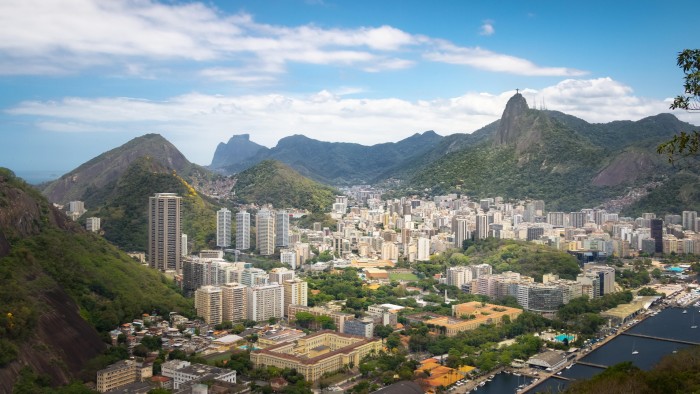Unlock the Editor’s Digest for free
Roula Khalaf, Editor of the FT, selects her favourite stories in this weekly newsletter.
The writer is global head of research at Ashmore Group
It is hard to talk about Brazil without acknowledging its potential. More than twice the size of India, Brazil is an energy, mining and agricultural powerhouse. It has a hyperconnected population, a well-educated middle-class and a sophisticated financial system. As per Jorge Ben Jor’s classic song “País Tropical”, it is a “tropical country blessed by god and beautiful by nature”.
Despite all its strengths, investor confidence in Brazil is very low. Unsustainable fiscal dynamics under President Luiz Inácio Lula da Silva led to humiliating valuation levels by the end of last year. But betting on a collapse of the country’s social-economic structure is a mistake. With the highest real rates in the world, a weak currency and equity markets trading near 2008 levels, Brazil offers an enticing value opportunity for international investors.
There are some signs of economic improvement that can be built on. GDP growth was 3.4 per cent in 2024, the strongest since 2011, excluding the pandemic rebound. Unemployment also fell from 15 per cent to 6.2 per cent, the lowest since 2015.
However, growth is projected to drop to about 2 per cent this year. Lula’s government has repeatedly undermined its commitment to fiscal responsibility. Recent measures include a bill raising the income tax exemption threshold to R$5,000 (US$850) per month, which would leave at least 56 per cent of the country’s workforce paying no income tax. The government’s proposal to offset these losses by taxing the wealthiest 0.1 per cent has done little to assuage investor concerns as its approval is uncertain. Furthermore, quasi-fiscal measures — such as payroll-linked credit extensions — potentially mask deeper deficits.
Fiscal profligacy has, in turn, prompted capital flight. A weaker currency has added to inflation, forcing the central bank to raise policy rates to 14.25 per cent today, or 10 per cent in real terms, the highest across emerging markets. This has put further strain on government finances. The cost of servicing debt accounts for most of the budget deficit, which stands at 8.5 per cent of GDP. Brazil’s net debt-to-GDP ratio is 61.4 per cent and gross debt approaches 76 per cent.
Elections are not until October 2026 but are very much on investors’ radars. Lula’s approval ratings recently dropped to historic lows of 24 per cent. Voters blame his economic policies for their falling purchasing power and fear the prospect of future tax rises.
This backdrop echoes that of the US, where the Democrats were voted out last year in part due to cost of living concerns. The parallel ends there, though. While Donald Trump passed through various court cases and was re-elected US president, Jair Bolsonaro is ineligible and likely to serve time for his role in plotting a coup to remain in power.
The opposition could now rally around Tarcísio de Freitas, the current governor of São Paulo and former infrastructure minister who was not caught in the net of criminal proceedings against Bolsonaro. A technocrat and former engineer, Tarcísio has led the completion of several infrastructure projects and the privatisation of electricity provider Eletrobras. He also oversaw the approval of market-friendly legal frameworks for natural gas, railways and cabotage shipping. His approval rating is high, and he has the lowest rejection rates among potential candidates.
Tarcísio becoming the opposition candidate and winning the election in 2026 could provide a positive confidence shock, boosting the currency and lowering inflation expectations. This would allow for rate cuts and therefore lower interest costs. Given the primary deficit is relatively small, lower interest rates would help to restore debt sustainability. Former presidents Fernando Henrique Cardoso and Michel Temer managed fiscal consolidations with anaemic GDP growth. Recent structural reforms under Lula suggest the economy can now expand by 2.5 to 3.5 per cent, making it easier to steer the country towards debt sustainability.
Brazil needs to build. Capex to GDP has been below 20 per cent since the 1990s. The next government, whoever forms it, should find budgetary resources for infrastructure investment by announcing a credible four-year fiscal consolidation plan that could include freezing public sector hiring, and keeping entitlements below nominal GDP. They could then spearhead a Brazilian infrastructure renaissance that would attract further investments from the private sector. If capex to GDP can rise above 20 per cent again within a credible budget, Brazil will be back on track.
